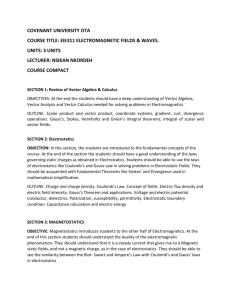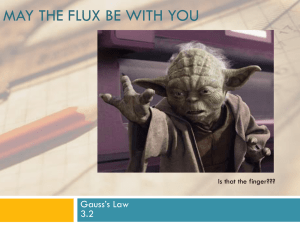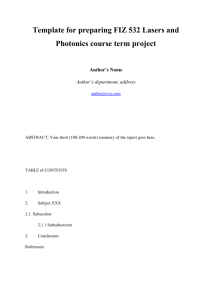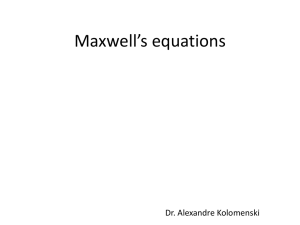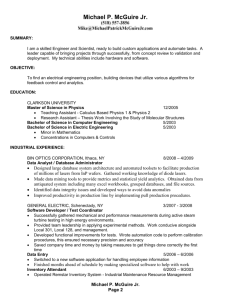Engineering Physics
advertisement
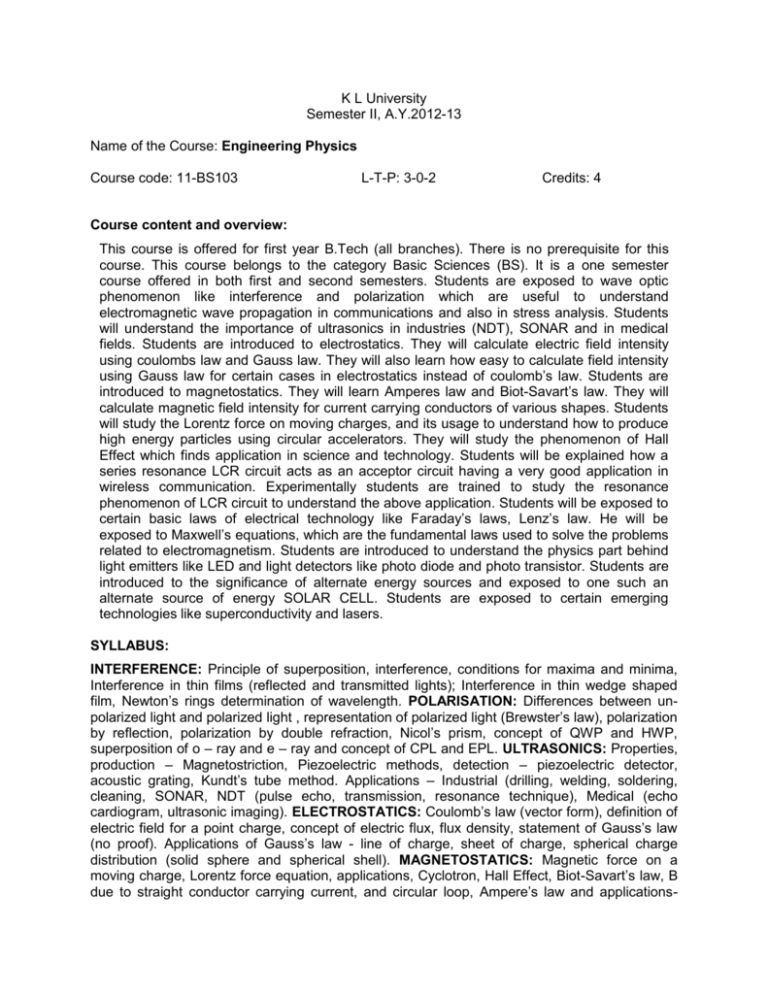
K L University Semester II, A.Y.2012-13 Name of the Course: Engineering Physics Course code: 11-BS103 L-T-P: 3-0-2 Credits: 4 Course content and overview: This course is offered for first year B.Tech (all branches). There is no prerequisite for this course. This course belongs to the category Basic Sciences (BS). It is a one semester course offered in both first and second semesters. Students are exposed to wave optic phenomenon like interference and polarization which are useful to understand electromagnetic wave propagation in communications and also in stress analysis. Students will understand the importance of ultrasonics in industries (NDT), SONAR and in medical fields. Students are introduced to electrostatics. They will calculate electric field intensity using coulombs law and Gauss law. They will also learn how easy to calculate field intensity using Gauss law for certain cases in electrostatics instead of coulomb’s law. Students are introduced to magnetostatics. They will learn Amperes law and Biot-Savart’s law. They will calculate magnetic field intensity for current carrying conductors of various shapes. Students will study the Lorentz force on moving charges, and its usage to understand how to produce high energy particles using circular accelerators. They will study the phenomenon of Hall Effect which finds application in science and technology. Students will be explained how a series resonance LCR circuit acts as an acceptor circuit having a very good application in wireless communication. Experimentally students are trained to study the resonance phenomenon of LCR circuit to understand the above application. Students will be exposed to certain basic laws of electrical technology like Faraday’s laws, Lenz’s law. He will be exposed to Maxwell’s equations, which are the fundamental laws used to solve the problems related to electromagnetism. Students are introduced to understand the physics part behind light emitters like LED and light detectors like photo diode and photo transistor. Students are introduced to the significance of alternate energy sources and exposed to one such an alternate source of energy SOLAR CELL. Students are exposed to certain emerging technologies like superconductivity and lasers. SYLLABUS: INTERFERENCE: Principle of superposition, interference, conditions for maxima and minima, Interference in thin films (reflected and transmitted lights); Interference in thin wedge shaped film, Newton’s rings determination of wavelength. POLARISATION: Differences between unpolarized light and polarized light , representation of polarized light (Brewster’s law), polarization by reflection, polarization by double refraction, Nicol’s prism, concept of QWP and HWP, superposition of o – ray and e – ray and concept of CPL and EPL. ULTRASONICS: Properties, production – Magnetostriction, Piezoelectric methods, detection – piezoelectric detector, acoustic grating, Kundt’s tube method. Applications – Industrial (drilling, welding, soldering, cleaning, SONAR, NDT (pulse echo, transmission, resonance technique), Medical (echo cardiogram, ultrasonic imaging). ELECTROSTATICS: Coulomb’s law (vector form), definition of electric field for a point charge, concept of electric flux, flux density, statement of Gauss’s law (no proof). Applications of Gauss’s law - line of charge, sheet of charge, spherical charge distribution (solid sphere and spherical shell). MAGNETOSTATICS: Magnetic force on a moving charge, Lorentz force equation, applications, Cyclotron, Hall Effect, Biot-Savart’s law, B due to straight conductor carrying current, and circular loop, Ampere’s law and applications- straight conductor carrying current, magnetic flux, Gauss’s law of magnetostatics, Maxwell’s equations (statement only) for static fields, LCR series resonant circuit. ELECTRODYNAMICS & MAXWELL’S EQUATIONS: Faraday’s laws with experiments, Lenz’s law, motional e.m.f, and transformer e.m.f with examples, induced electric fields, concept of displacement current, Maxwell’s equations (statement only) for time varying fields. SEMICONDUCTOR PHYSICS: Types of solids – conductors, semiconductors, insulators; bonding in semiconductors; types of semiconductors; construction and working of PN junction diode. OPTO ELECTRONIC DEVICES: Photo electric effect, light emitters – LED; light detectors – Photo diode, Photo transistor; solar cells – principle, fabrication and its applications. SUPERCONDUCTIVITY: Introduction, properties, Experimental facts – resistance Vs temperature, Meissner effect, Josephson Effect, critical parameters, type I and II superconductors, HTS, applications. LASERS: Characteristics, stimulated & spontaneous emission, population inversion, metastable states, pumping mechanisms, Ruby, He:Ne, GaAs lasers, application of lasers in engineering & medicine. SCOPE AND OBJECTIVE OF THE COURSE: This course explores the fundamental principles and concepts of Physics from different topics such as wave optics, ultrasonic’s, electromagnetism, superconductivity, lasers and optoelectronic devices needed for all engineering students, which they can readily relate to the engineering problems that they would be addressing in their course work. COMPETENCIES: At the end of the course the student should be able to C1 C2 C3 C4 C5 C6 C7 C8 C9 C10 C11 C12 C13 C14 Calculate the resultant amplitude and intensity when two or more light waves get superimposed.(2) Derive the conditions for interference maxima and minima.(3) Explain the production of plane polarized light using different techniques and to detect different types of polarized lights.(4) Explain how ultrasonic waves are produced and detected.(4) Determine flaws present inside a material using NDT techniques.(5) Compute the electric field by Gauss’s Law.(3) Compute the magnetic induction produced by current carrying conductors by using BiotSavart law and Ampere’s law.(3) Compute the Lorentz force experienced by a charged particle.(2) Determine resonance frequency and Q factor of an RLC circuits.(1) Compute motional emf and transformer emf and formulate Maxwell’s equation for time varying fields.(3) Understand bonding in semiconductors and working of PN junction diode.(2) Explain the working of optoelectronic devices including LED, LCD and solar cells.(4) Explain the phenomenon of superconductivity.(5) Describe the elements of laser system.(4) BOOKS: Text Books: 1) Physics Volume II 5th Edition, Resnick, Halliday and Krane. 2) Engineering Physics, 2nd edition, P. K Palanisamy, Sci Tech publications (India) Pvt.Ltd, Chennai. Reference Books: 1) University Physics, 6th edition, Francis W.Sears, Mark W Zemansky, Hugh D Young, Norsa Publishing House. 2) Solid State Physics, 6th Edition, S.O.Pillai, Newage International Publishers. 3) Optics, 2nd Edition by Ajay Ghatak, Tata Mc Grahill Publications 4) Applied Physics, P.K.Palanisamy, Scitech publications (India) Pvt.Ltd, Chennai. 5) Engineering Physics, 8th Edition, R K Gaur and S L Gupta, Dhanpat Rai Publications.
